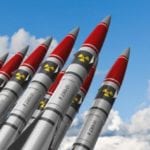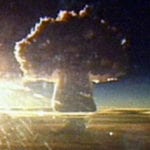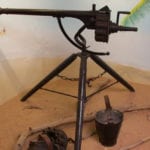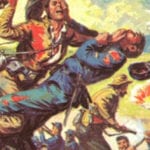 Our World
Our World  Our World
Our World  Miscellaneous
Miscellaneous 10 Intriguing Origins of Popular Carnival Rides
 Weird Stuff
Weird Stuff Ten Unexpected Discoveries Involving Vomit
 Movies and TV
Movies and TV 10 Actors Who Almost Didn’t Take Career-Defining Roles
 Technology
Technology 10 Little-Known Shifts in Computer Science
 Religion
Religion 10 Catholic Histories That Reveal Acceptance of Abortion and Contraception
 Politics
Politics 10 Lesser-Known “First and Only” Facts about U.S. Presidents
 Miscellaneous
Miscellaneous 10 Things You May Not Know about the Fourth of July
 History
History 10 Shocking and Gruesome Founding Father Facts They Don’t Teach in School
 Crime
Crime The Ten Most Vicious Los Angeles Killers
 Our World
Our World 10 Surprising Secrets of Notre Dame Cathedral
 Miscellaneous
Miscellaneous 10 Intriguing Origins of Popular Carnival Rides
 Weird Stuff
Weird Stuff Ten Unexpected Discoveries Involving Vomit
Who's Behind Listverse?

Jamie Frater
Head Editor
Jamie founded Listverse due to an insatiable desire to share fascinating, obscure, and bizarre facts. He has been a guest speaker on numerous national radio and television stations and is a five time published author.
More About Us Movies and TV
Movies and TV 10 Actors Who Almost Didn’t Take Career-Defining Roles
 Technology
Technology 10 Little-Known Shifts in Computer Science
 Religion
Religion 10 Catholic Histories That Reveal Acceptance of Abortion and Contraception
 Politics
Politics 10 Lesser-Known “First and Only” Facts about U.S. Presidents
 Miscellaneous
Miscellaneous 10 Things You May Not Know about the Fourth of July
 History
History 10 Shocking and Gruesome Founding Father Facts They Don’t Teach in School
 Crime
Crime The Ten Most Vicious Los Angeles Killers
10 Times The Military Mistakenly Dropped Nuclear Bombs
“Broken arrows” are nuclear accidents that don’t create a risk of nuclear war. Examples include accidental nuclear detonations or non-nuclear detonations of nuclear weapons. So far, the US Department of Defense recognizes 32 such incidents. They’re sobering examples of how one tiny mistake could potentially cause massive unintentional damage.
10British Columbia
1950

The first recorded American military nuclear weapon loss took place in British Columbia on February 14, 1950. A Convair B-36 was on its way from Eielson Air Force Base near Fairbanks, Alaska to the Carswell Air Force Base in Fort Worth, Texas. The bomber was scheduled to take part in a mission that simulated a nuclear attack on San Francisco. The role of the bomber was to see if these kinds of planes could perform bomb runs in extremely cold weather. That way, the military could see how the bomber would perform if it ever got attacked by the Soviets and had to respond.
Because it was meant to go on a mock bomb run, the plane was carrying a Mark IV atomic bomb. However, the military wasn’t actually planning to nuke anybody, so the bomb didn’t contain the plutonium core necessary for a nuclear detonation. Even so, it still had about 2,250 kilograms (5,000 lb) of regular explosives, so the Mark IV could still create a huge explosion.
In one way, the mission was a success. The military wanted to find out whether or not the B-36 could attack the Soviets during the Arctic winter, and they learned the answer—it couldn’t. Due to the harsh weather conditions, three of the six engines failed. The crew was forced to bail out, but they first jettisoned the Mark IV and detonated it over the Inside Passage in Canada. Five of the 17 men aboard the B-36 died.
9Mars Bluff, South Carolina
1958

Mars Bluff isn’t a sprawling metropolis with millions of people and giant skyscrapers. It’s a tiny, unincorporated community located in Florence County, South Carolina. However, it does have one claim to fame—on March 11, 1958, Mars Bluff was accidentally bombed by the United States Air Force with a Mark 6 nuke.
A Boeing B-47E-LM Stratojet departed from Hunter Air Force Base in Savannah, Georgia and was headed to England. It was part of Operation Snow Flurry, in which bombers flew to England to perform mock drops to test their accuracy. The Boeing in question had a Mark VI nuclear bomb onboard. As with the British Columbia incident, the bomb was inactive but still had thousands of pounds of explosives.
This one is entirely the captain’s fault. While he was performing checks on the bomb, he accidentally grabbed the emergency release pin. This released the bomb from its harness, and it fell right through the bomber doors to the ground 4,500 meters (15,000 ft) below.
The bomb landed on the house of Walter Gregg. Fortunately, nobody was killed in the ensuing explosion, although Gregg and five other family members were injured. Gregg sued the Air Force and was awarded $54,000 in damages, which is almost $500,000 in today’s money.
8Minot, North Dakota
2007

Don’t think that fumbles with nuclear weapons are a thing of the past; the most recent such incident happened in 2007 at the Minot Air Force Base in North Dakota.
The mission was supposed to be pretty simple—deliver a load of unarmed AGM-129 ACM cruise missiles to a weapons graveyard. A dozen of them were loaded onto a B-52, six on each side. The officer in charge came and gave a quick inspection with a passing glance at the missiles on the right side before signing off on the mission. If he bothered to look on the left side, he would have noticed something quite interesting—the six missiles were all still armed with nuclear warheads, each with the power of 10 Hiroshima bombs.
This fun fact went unnoticed for the next 36 hours. During that time, the missiles flew across the country to Louisiana without any kind of safety protocols in place or any other procedure normally required when transporting nuclear weapons.
In the end, things turned out fine, which is why this incident was never classified as a broken arrow. Rather, it’s a “bent spear,” an event involving nuclear weapons of significant concern without involving detonation. Even so, when word got out, the public was quite distressed to find out exactly how easily six incredibly dangerous nuclear weapons can get misplaced through simple error.
7Tybee Island, Georgia
1958

The year 1958 wasn’t a brilliant year for the US military. This is the second of three broken arrow incidents that year, this time taking place in the waters off Tybee Island near Savannah, Georgia.
A 3,500-kilogram (7,600 lb) Mark 15 nuclear bomb was aboard a B-47 bomber engaged in standard practice exercises. What was not so standard was an accidental collision with an F-86 fighter plane, significantly damaging the B-47’s wing. The bomber was barely airborne, so the crew jettisoned the bomb in preparation for an emergency landing.
The bomb was jettisoned over the waters of the Savannah River. To the crew’s surprise, they never heard an explosion. The pilot guided the bomber safely to the nearest air force base and even received a Distinguished Flying Cross for his actions. However, there was still one question left unanswered—where was the giant nuclear bomb?
That’s a question still unanswered today. The bomb was never found. Even now, over 55 years after the accident, people are still looking for it. Experts agree that the bomb ended up somewhere at the bottom of the Wassaw Sound, where it should still be today, buried under several feet of silt.
6Mediterranean Sea
1956

The military does have a tendency to lose a nuclear weapon every now and then without ever recovering it. However, in these cases, they at least have some idea of where the bombs ended up. That is not the case with this broken arrow. It is, without a doubt, the most mysterious incident of its kind.
On March 10, 1956, a B-47 Stratojet took off from MacDill Air Force Base in Florida carrying capsules with nuclear weapon cores. It was headed to a then-undisclosed foreign military base, later revealed to be Ben Guerir Air Base in Morocco. During the flight, the bomber was supposed to undergo two aerial refueling sessions. The first one went off without a hitch. When the second tanker arrived to meet up with the B-47, the bomber was nowhere to be found.
And it was never found again. It had disappeared without a trace over the Mediterranean Sea.
The Royal Navy organized extensive searches assisted by French and Moroccan troops stationed in the area. The best they could come up with is a report that the plane went down somewhere near a coastal village in Algeria called Port Say. The plane and its cargo was eventually classified “lost at sea,” and the three crew members were declared dead.
5San Antonio, Texas
1963

This is a unique case, even for a broken arrow, and it goes to show that even obsolete nuclear weapons need to be handled with care as they are still dangerous.
The incident took place at Lackland Air Force Base in San Antonio. Specifically, it occurred at the Medina Base, an annex formerly used as a National Stockpile Site (NSS). Back in the ’60s, it was also used to decommission and disassemble old nuclear weapons.
On November 13, 1963, the annex experienced a massive chemical explosion when 56,000 kilograms (123,000 lb) of non-nuclear explosives detonated. Shockingly, there were no casualties, and only three workers received minor injuries. The nuclear components were stored in a different part of the building, so radioactive contamination was minimal.
The incident became public immediately but didn’t cause a big stir because it was overshadowed when, just a few days later, President Kennedy was assassinated in Dallas.
4Fairfield, California
1950
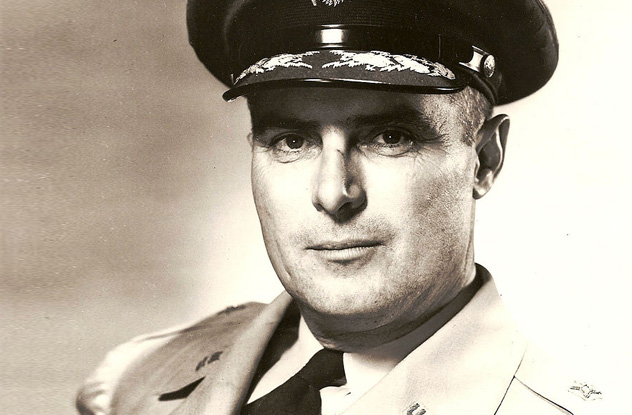
This is one of the most serious broken arrows in terms of loss of life. By the end, 19 people were dead, and almost 180 were injured. Among the victims was Brigadier General Robert F. Travis.
The incident took place at the Fairfield-Suisun Air Force Base in California. The Korean War was raging, and the military was transporting a load of Mark IV nuclear bombs to Guam. Ten B-29 bombers were loaded with one nuclear weapon each.
Shortly after takeoff, one of the planes developed engine trouble. General Travis, aboard that plane, ordered it back to the base, but another error prevented the landing gear from deploying. The pilot had to crash-land the B-29 in a remote area of the base. Of the 20 people aboard the plane, 12 died on impact, including Travis. Ground personnel tried to put out the fire before the bomb would explode, but the Mark IV detonated, and the 2,300 kilograms (5,000 lb) of conventional explosives caused a massive blast that killed seven more people.
The military tried to cover up the incident by claiming that the plane was loaded with only conventional explosives. The accident report made no mention of nuclear weapons aboard the bomber. The base was soon renamed “Travis Air Force Base” in honor of the general.
3Palomares, Spain
1966

The incident that happened in Palomares, Spain on January 17, 1966 was a bad one, even for a broken arrow. For starters, it involved the destruction of two different aircraft and the deaths of seven of the people aboard them. Moreover, it involved four hydrogen bombs, two of which exploded. Lastly, it all took place in a foreign land, hurting the United States politically.
A B-52G bomber was flying over the Mediterranean Sea when it was approached by a tanker for a standard mid-air refueling. The two planes collided, and both were completely destroyed. The bomber had been carrying four MK28 hydrogen bombs. One landed in a riverbed and was fine—it didn’t leak; it didn’t explode. Another fell in the sea and was recovered a few months later. Two bombs landed near the Spanish village of Palomares and exploded on impact. They contaminated a 2.5-square-kilometer (1 mi2) area, although nobody was killed in the blasts.
A few months later, the US government was sued by Spanish fisherman Francisco Simo Ortis, who had helped find the bomb that fell in the sea. According to maritime law, he was entitled to the salvage reward, which was 1 percent of the haul’s total value. Luckily for him, the value of that salvage happened to be $2 billion, so he asked for $20 million. He settled out of court for an undisclosed sum.
2Greenland
1968

This Greenland incident, commonly referred to as the Thule accident, took place just two years after Palomares and has a lot of similarities with the previous broken arrow. It involved four different hydrogen bombs, and it took place in a foreign land, causing diplomatic problems for the United States.
On January 21, 1968, a B-52 bomber carrying four hydrogen bombs was flying over Baffin Bay in Greenland when the cabin caught fire. Originally, the plan was to make an emergency landing at Thule Air Base, but the fire was too severe, and the plane didn’t make it there. Six of the seven crew members made it out alive, while the bomber crashed into the sea ice.
One of the bombs detonated, spreading radioactive contamination over a 300-meter (1,000 ft) area. All of the contaminated snow and ice—roughly 7,000 cubic meters (250,000 ft3)—was removed and disposed of by the United States. Another bomb simply burned without exploding, and two others fell into the icy waters. One of those was eventually recovered about 10 years later, but the other one is still somewhere at the bottom of Baffin Bay.
Oddly enough, the Danish government got into more trouble than the American one. Greenland is a territory administered by Denmark, and the country had implemented a nuclear-free policy in 1957. In what would eventually get dubbed “Thulegate,” it came out that the Danish government was secretly allowing the stockpiling of nuclear weapons on its soil during peacetime.
1Albuquerque, New Mexico
1957

We’ve finally arrived at the most famous broken arrow in US history, one mostly made famous by the government covering it up for almost 30 years.
On May 22, 1957, a B-36 bomber was transporting a giant Mark 17 hydrogen bomb from Texas to the Kirtland Air Force Base near Albuquerque, New Mexico. This was one of the biggest nuclear bombs ever made, 8 meters (25 ft) in length and with an explosive yield of 10 megatons.
Everything was going fine until the plane was about 6 kilometers (4 mi) from the base. Then, for reasons that remain unknown, the bomb’s safety harness failed. The giant hydrogen bomb fell through the bay doors of the bomber and plummeted 500 meters (1,700 ft) to the ground.
Two pieces of good news came after this. First, the plutonium pits hadn’t been installed in the bomb during transportation, so there was no chance of a nuclear explosion. Second, the bomb landed in a mostly empty field. It produced a giant explosion, left a 3.5-meter (12 ft) deep crater, and spread radioactive contaminants over a 1.5-kilometer (1 mi) area. But the damage was minimal, and there was only one casualty—an unfortunate cow that was grazing in the vicinity of the explosion.
For 29 years, the government kept the accident at Kirtland a secret. This practically ensured that, when it was eventually revealed, everyone treated it like a huge deal, even though much worse broken arrows had happened since.
Radu is a history and science buff who writes for GeeKiez when he isn’t writing for Listverse.

